Fitness Guru Sean Hyson Provides Your 2015 Fitness Tips In New eBook 'The Truth About Strength Training'

Jan. 7 2015, Updated 4:18 p.m. ET
Fitness expert Sean Hyson, C.S.C.S. — the training director for Men's Fitness and Muscle & Fitness magazines — will help you fulfill that 2015 New Year's resolution to get in shape and lose that gut with his new e-book, The Truth About Strength Training.
In it, Hyson gives readers a 12-week program to kick the year off on the right path, eliminating the fluff by simplifying the workout and diet information (that inevitably contradicts itself with the more info you seek out).
No carbs or more carbs? Bodybuilding or Crossfit? Supplements or not?
All of the answers, and then some, are in Hyson's book, as he drew upon more than a decade of experience as a fitness journalist to provide readers with a clear, concise path to a trimmer waistline.
Watch the video on RadarOnline.com
In a special preview, right here on RadarOnline.com, we have Hyson's top three tips heading into the new year.
1. Don't Fear Carbs
Cutting back on the intake of carbohydrates is a popular method for losing weight, but there's no real magic behind why it works. Dieters typically eliminate processed foods such as cereal, pasta, and bread, thereby reducing the number of calories they consume from foods that lack nutrition. Success with this strategy has led to the rise of ketogenic diets — where carbs are restricted to around 50 grams per day or fewer — in hopes of spurring even faster and more dramatic weight loss. Science, however, doesn't support this. A study in the American Journal of Clinical Nutrition found that a ketogenic diet was no more effective than a more conventional low-carb diet — where subjects ate upwards of 150 grams of carbs. On top of that, the ketogenic dieters seemed to experience higher levels of inflammation. The fact is, carbs are the body's preferred source of fuel for exercise. If you lift weights (and you should, if your goal is to have a muscular, athletic physique), extreme low-carb diets deprive you of the energy you need for intense workouts. To lose fat, cut back on processed foods and let your carbs come from potatoes, sweet potatoes, rice, vegetables, and fruit. Aim to reduce the overall calories you consume, rather than restrict a particular nutrient, and your weight will go down.
2. Choose The Right Exercises
Don't let inexperienced personal trainers, YouTube videos, or shows like The Biggest Loser determine your exercises for you. The best workout moves are the ones you can perform safely and consistently, not the ones that seem to be the most popular. If it hurts your knees to squat or your shoulder to bench press, find substitutions. Single-leg exercises, including variations of lunges, are excellent lower-body builders and are easy on your back and knees. For the upper body, you can do your pressing movements with dumbbells and palms facing each other rather than facing away from you. Called a “neutral” grip, it relieves pressure on your shoulders. As for cardio, don't bother with running unless you really enjoy it. According to research done by the Mayo Clinic, an hour of high-impact cardio only burns around 530 calories, while a healthy meal of chicken and rice contains 385. In other words, cardiovascular exercise—even when it's highly intense — doesn't burn many more calories than you can eat in a single sitting. It's not an efficient method for fat loss (adjusting your diet is).
3. Do Less Work (More Often)
The amount of time you need to put in at the gym to see results is probably much less than you think. Three to four days of lifting for no more than an hour per session is enough when coupled with a balanced diet. Cardio, while a healthy addition to any workout plan, is optional (largely because it doesn't do much to speed fat loss, as explained above). These are the basics of the program featured in The Truth About Strength Training, which has yielded impressive results for men and women in 12 weeks. The author himself lost 30 pounds while gaining significant muscle. If your current gym sessions have you hammering one or two body parts at a time with multiple exercises and lots of sets, you're doing too much work to see optimal gains. Consider how long it takes to recover from a workout that leaves you terribly sore — that's why most guys get in only one workout per week for chest, back, legs, etc. And one exposure a week isn't much of a stimulus for growth. Now imagine if you cut the work in half and trained each muscle group twice per week. You could send your muscles the message to grow twice as often and experience half the soreness as a result. For example, replace “chest days” with upper-body workouts, where you train the chest, shoulders, back and arms in one session. Repeat the workout later in the week with different exercises. Now, instead of working your chest 52 times per year, you can potentially hit it 104 times, effectively doubling your efforts and setting you up to make gains twice as fast.

The Truth About Strength Training — on SALE now through Saturday — is available at www.truthaboutstrengthtraining.com.


